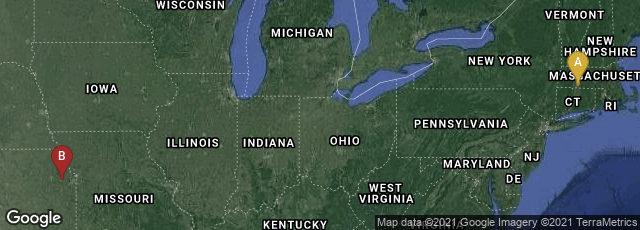
A: Springfield, Massachusetts, United States, B: Lawrence, Kansas, United States
"Typescript document signed ("James Naismith 6-28-31"), 2 pages (10 x 8 in.; 254 x 203 mm), [Springfield, Massachusetts, December 1891], being the original rules for the game of Basketball as typed up the very morning that Naismith introduced his new sport to the world, 46 lines enumerating 13 rules, titled at the top of the first page in Naismith's hand "Basket Ball," with one three-word autograph emendation, and endorsed by him at the bottom of the second page "First draft of Basket Ball rules. Hung in the gym that the boys might learn the rules—Decr 1891"; first page very lightly soiled, both pages a tiny bit faded, a few stains from careless transparent tape and other adhesive repairs attempted by Naismith himself, both sheets mounted on slightly larger pieces of mat board, again by Naismith, in anticipation of the rules being framed (which he never did)." (Sotheby's).
In December 1891 Canadian sports coach, physician, and innovator, James Naismith, invented basketball as an indoor sport to be played in winter by writing thirteen rules for the new sport and posting these rules in the Springfield, Massachusetts YMCA gym. As far as I know, this is the only major sport in which the invention can be traced to a specific document.
"The first game of "Basket Ball" was played in December 1891. In a handwritten report, Naismith described the circumstances of the inaugural match; in contrast to modern basketball, the players played nine versus nine, handled a soccer ball, not a basketball, and instead of shooting at two hoops, the goals were a pair of peach baskets: 'When Mr. Stubbins brot [sic] up the peach baskets to the gym I secured them on the inside of the railing of the gallery. This was about 10 feet from the floor, one at each end of the gymnasium. I then put the 13 rules on the bulletin board just behind the instructor's platform, secured a soccer ball and awaited the arrival of the class... The class did not show much enthusiasm but followed my lead. . . I then explained what they had to do to make goals, tossed the ball up between the two center men & tried to keep them somewhat near the rules. Most of the fouls were called for running with the ball, though tackling the man with the ball was not uncommon.' In contrast to modern basketball, the original rules did not include what is known today as the dribble. Since the ball could only be moved up the court via a pass early players tossed the ball over their heads as they ran up court. Also, following each 'goal' a jump ball was taken in the middle of the court. Both practices are obsolete in the rules of modern basketball
"By 1892, basketball had grown so popular on campus that Dennis Horkenbach (editor-in-chief of The Triangle, the Springfield college newspaper) featured it in an article called 'A New Game', and there were calls to call this new game 'Naismith Ball', but Naismith refused. By 1893, basketball was introduced internationally by the YMCA movement. From Springfield, Naismith went to Denver where he acquired a medical degree and in 1898 he joined the University of Kansas faculty at Lawrence, Kansas" (Wikipedia article on James Naismith, accessed 12-11-2010).
♦ On December 10, 2010 Sotheby's in New York auctioned Naismith's original typewritten and hand-written manuscript of the rules which created basketball. To promote the sale, which benefited the Naismith Basketball Foundation. The document sold for $4,338,500, including buyer's premium. According to CBSsports.com, the buyers were David and Suzanne Booth, who intended to donate the manuscript to the University of Kansas at Lawrence where Naismith was the first basketball coach. Mr. Booth is an alumnus of the University of Kansas. The price was a record high for sports memorabilia.